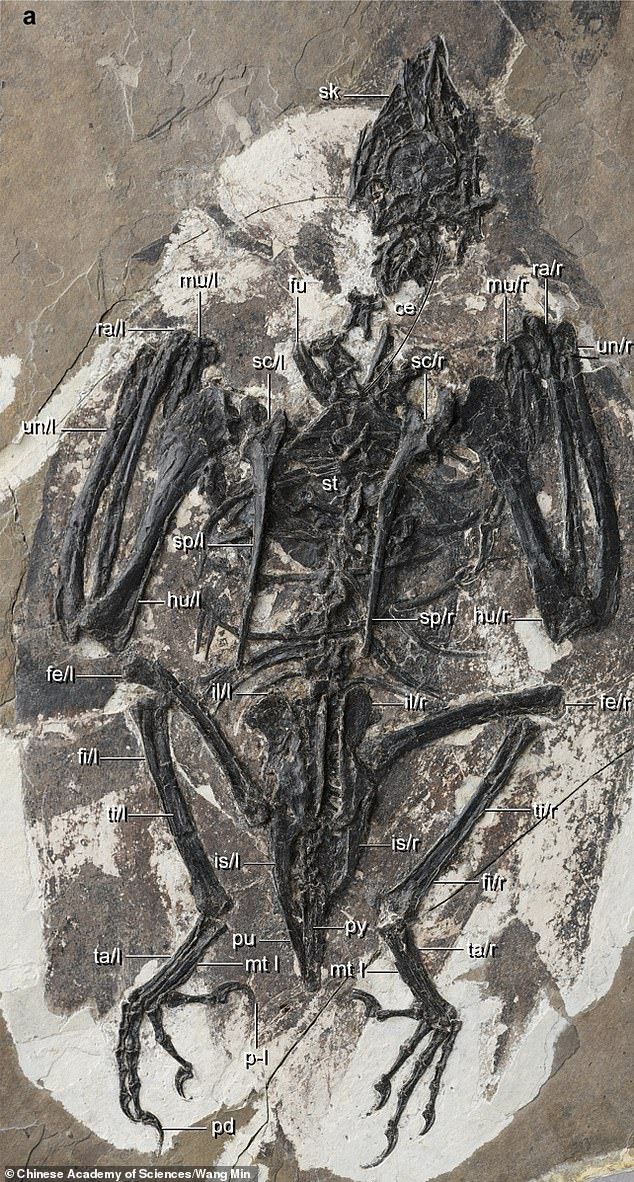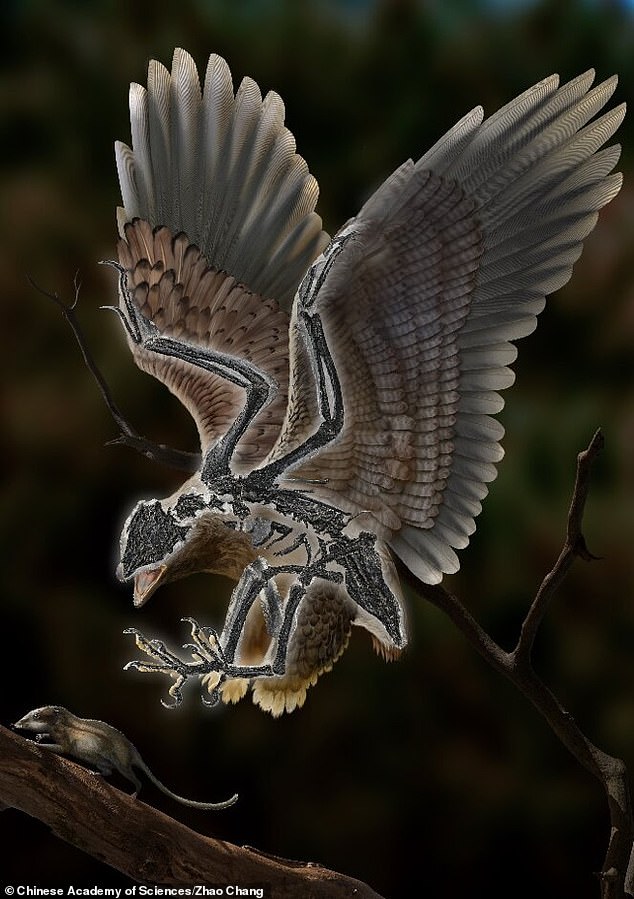Bizarre dinosaur-bird hybrid soared over China 120 million years ago
>
Bizarre dinosaur-bird HYBRID with a head like T.Rex soared over China 120 million years ago, fossil analysis reveals
- A newly-found fossil may offer important insights into evolution of modern birds
- Cratonavis zhui lived some 120 million years ago in what today is northern China
- The bizarre dinosaur-bird hybrid had a head like Tyrannosaurus Rex, experts say
- However, a body print reveals it had a body more in common with modern birds
<!–
<!–
<!–<!–
<!–
<!–
<!–
A bizarre dinosaur-bird hybrid with a head like Tyrannosaurus Rex soared over China 120 million years ago, fossil analysis has revealed.
While the creature’s head was dinosaur-like, palaeontologists say its body was more in keeping with that of today’s birds.
They discovered the body print fossil, named Cratonavis zhui, during excavations in northern China, a region where prints of feathered dinosaurs and early birds have also been unearthed.
The unusual discovery is important because it could help to provide an insight into how modern birds evolved.

Peculiar: A bizarre dinosaur-bird hybrid which had a head like Tyrannosaurus Rex soared over China 120 million years ago, fossil analysis has revealed. Experts discovered the body print fossil, named Cratonavis zhui, during excavations in northern China (pictured)
It was found in sedimentary rocks which formed about 120 million years ago during the Cretaceous period.
Experts led by palaeontologist Zhou Zhonghe, from the Chinese Academy of Sciences, carried out CT scans of the creature’s skull print and found that its shape was almost the same as that of dinosaurs like T.Rex, rather than being bird-like.
They believe that in the avian branches of the dinosaur family tree, Cratonavis sits between the reptile-like Archaeopteryx and the Ornithothoraces, which had already developed many of the traits of modern birds.
‘The primitive cranial features speak to the fact that most Cretaceous birds such as Cratonavis could not move their upper bill independently with respect to the braincase and lower jaw, a functional innovation widely distributed among living birds that contributes to their enormous ecological diversity,’ said fellow palaeontologist Zhiheng Li.
Previous studies have found similar half dinosaur, half bird creatures but what has not been established is the order in which evolutionary changes in shape, function and environment began to happen to lead to the modern birds we see today.
The Chinese researchers also found that Cratonavis had a surprisingly long scapula and first metatarsal, both of which are rarely seen in the fossils of other dino-ancestors to birds.
In terms of the metatarsal, this decrease in size as birds developed and is now entirely absent, while an elongated scapula has been observed previously in Cretaceous birds such as Yixianornis and Apsaravis.


Experts from the Chinese Academy of Sciences carried out CT scans of the creature’s skull print and found that its shape was almost the same as that of dinosaurs like T.Rex, rather than being bird-like. Pictured is an artist’s impression of the creature
It is an important discovery in Cratonavis because it suggests the species may have contributed to a biological experiment in flying behaviour.
Although Cratonavis would not have been able to fly, it hints at the gradual evolution from more of a land-based dinosaur to a bird capable of taking to the skies.
It also backs up previous research on the importance of evolutionary mosaicism in the early diversification of birds.
This is a scientific theory that traits can evolve independently from each other and at a different rate.
One of the lead authors, palaeontologist Min Wang, said: ‘The elongate scapula could augment the mechanical advantage of muscle for humerus retraction/rotation, which compensates for the overall underdeveloped flight apparatus in this early bird, and these differences represent morphological experimentation in volant behaviour early in bird diversification.’
The study has been published in the journal Nature Ecology & Evolution.
If you enjoyed this article…
Asia’s oldest-known stegosaur is among 351 new animal and plant species uncovered by Natural History Museum scientists in 2022
Tadpole shrimp that have lived on Earth for 550 million years have been seen by tourists in Arizona
And a microraptor died 120 million years ago with the FOOT of a small animal lodged in its ribcage

